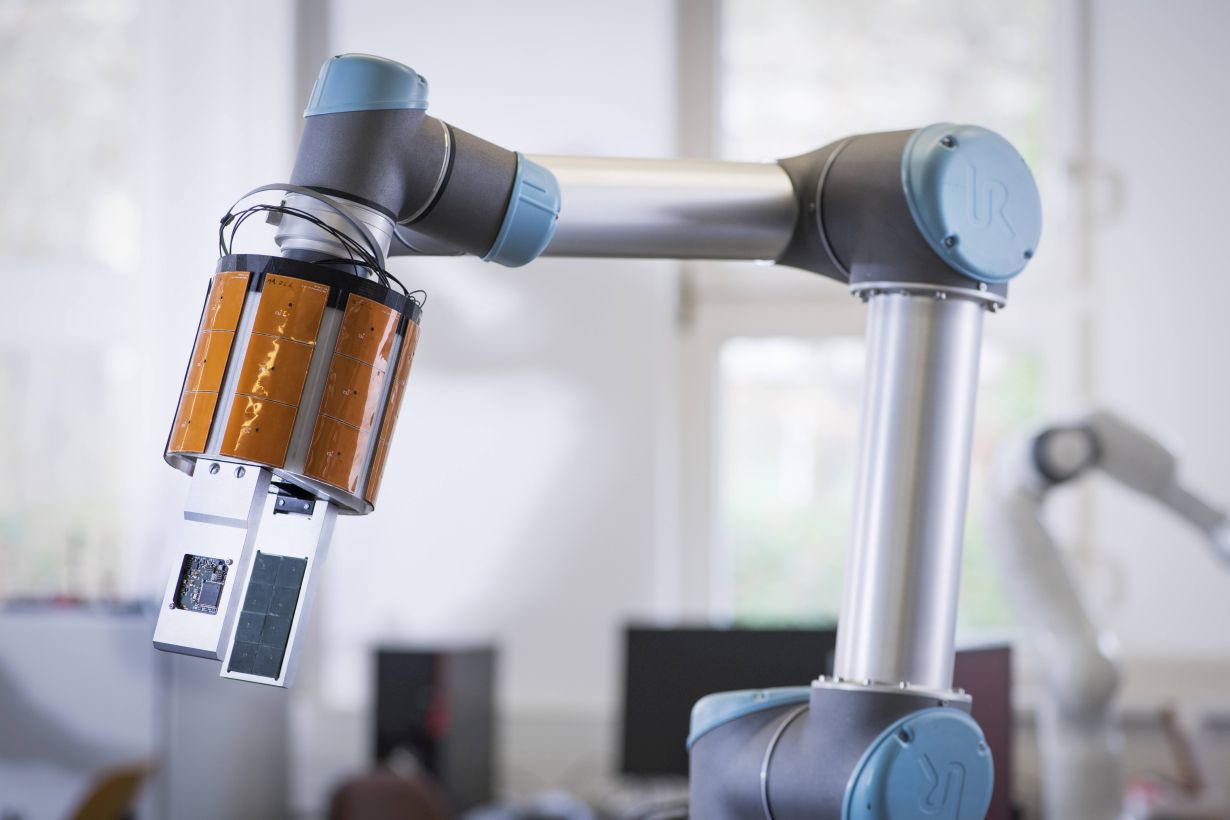Intelligent sensors for human-robot collaboration, a flexible test lab for the future power grid, innovative energy storage systems and electric motors: These are some of the research activities presented by Karlsruhe Institute of Technology (KIT) at Hannover Messe 2018 with this year’s lead theme “Integrated Industry – Connect & Collaborate.” From April 23 to 27, 2018, KIT will present its work at two leading trade shows again: At “Research & Technology” (hall 2, stand B16) and at “Energy” (hall 27, stand K51). The multimodal sensor technology for industrial robots will be presented at the Highlight Tour for the media on April 22nd, starting at noon.
“The energy transition and Industry 4.0 are two major elements of a far-reaching change that makes us face big challenges. At the same time, they give rise to great opportunities for positive and sustainable developments in our society, industry, and environment,” says the President of KIT, Professor Holger Hanselka. “We need appropriate technologies to combine these different elements in a reasonable way. Development and introduction of these technologies require close collaboration of science and industry. I am very happy that KIT – The Research University in the Helmholtz Association will present its innovations at two big stands at Hannover Messe again: innovative processes and technologies for industrial production will be displayed at the leading trade show “Research & Technology.” Future-oriented solutions for energy supply will be presented at the leading trade show ’Energy.’”
Information on the stands and exhibits of KIT at Hannover Messe 2018 is also given in our digital press kit: www.kit.edu/hannovermesse2018
KIT in Hall 2, B16 – “Research and Technology”
Intelligent robots perceive their environment and react to it. For this, they need sensors that simultaneously detect different physical events. However, sensors that have been applied in arms and grippers of robots so far are mostly limited to one function: They perceive movements either by an approaching object or by contact in the form of pressure. KIT researchers have developed multimodal sensors that detect both simultaneously and, thus, ideally complement optical systems, such as cameras. With such capacitive tactile proximity sensors (CTPS), flexibility and agility of automated industrial production can be increased considerably, safety is enhanced. The sensors are able to detect approaching persons even when cameras are hidden or affected by unfavorable light conditions. As soon as a predefined safety distance is exceeded, they trigger warnings or reduce the speed of the robot. Hence, the CTPS can make an important contribution to safe human-robot collaboration when humans and robots work on the same workpiece at the same time.
The multimodal sensor technology for industrial robots will be presented at the Highlight Tour for the media on April 22nd, starting at noon.
ProLemo: Production Technologies for Lightweight Motors
Existing electric motors of high performance are optimized for driving machines and plants, which is why their development, construction, and production focus on fatigue strength and service life. Size, efficiency, and weight often play a minor role only. Hence, these motors mostly are too heavy, too large, and too expensive for use in vehicles. Within the ProLemo cooperation project, engineers developed new production technologies for lightweight electric motors and use lightweight construction materials (fiber-reinforced composites, soft magnetic composites). Moreover, they optimized the automatic copper winding process for reaching a high degree of filling. The motor developed by engineers of KIT in cooperation with industry partners is 20% lighter than a reference motor of the same performance class.
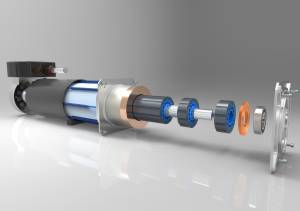
Setup of the lightweight motor, whose weight is reduced by about 20% compared to a reference motor of the same performance class. (Graphics: ProLemo)
Research 4.0: Virtual Atomization Test Rig for Fully Digital Flow Experiments
Flow of fluids and gases plays an important role in a number of industrial processes, an example being gasoline or diesel injection into combustion engines that decisively influences the formation of environmentally hazardous nitrogen oxides and soot. Computer-aided systems for flow simulation are applied to determine optimum flow for certain applications. In case of multi-phase flows, however, conventional methods reach their limits. Researchers of KIT have developed a simulation method based on smoothed particle hydrodynamics, a numerical method: Fluids and gases are divided into mass parcels, called particles, that move according to the laws of fluid mechanics. Flow fields can be simulated true to reality by the movement and interaction of these individual particles. Based on this approach, the researchers have developed a virtual test rig that covers all important steps of flow simulation, from preprocessing of the CAD data to flow computation to visualization. Apart from conventional animation technologies, virtual reality is used to analyze simulation results from all perspectives and to interact with them.
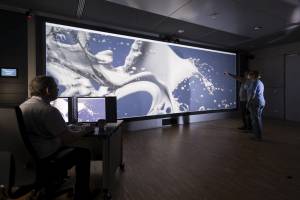
Analysis of an atomized fluid with VR glasses at the virtual test rig. (Photo: KIT)
IPEK-PTP: Automatic Power Tool Test Lab for Analysis and Modeling of User Influence on Power Tools
As it is difficult to reproduce the interaction of user, power tools, such as drilling machines, and the surface to be machined in test series, tests during the development of new power tools are very complex and expensive. At the Power Tool Test Lab of KIT, these complex interactions can be studied. The core component is the automatic power tool test rig that combines an industrial robot with a mechanical hand-arm model. The robot reproduces active movements of the user, while the hand-arm model simulates the passive influence of the human locomotive system. The tests reduce the scattering of experimental data compared to manual tests as well as the test staff’s exposure to vibrations, noise, and dust. Other components of the Power Tool Test Lab are a user interaction test rig to study vibration properties of the user and the flexible surface positioning system, by means of which the power tools can be tested on various surfaces and with various spatial orientations.
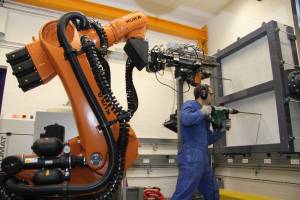
The Power Tool Test Lab allows for reproducible test conditions in product development. (Photo: IPEK, KIT)
IPEK-sCiL: Power-scaled Testing of Prototypes
Product developers, also of e.g. power tools, frequently use product series to reuse components with the same function, but other dimensions and sizes in products of various power classes. Often, however, the prototypes available for product tests have a mechanical loadability that does not exactly correspond to that of the real components in the series product. Engineers of KIT have developed the IPEK-scaled-Components-in-the-Loop approach (IPEK-sCiL), i.e. a method, by means of which prototypes can be integrated in a power test rig and operated in a power-scaled manner. In this way, interactions of existing system components with a virtually integrated physical prototype can be simulated in the test rig. This approach enables early assessment of a complete system, e.g. a power tool, even before all series components are available.

Test rig with integrated power-scaled prototype components according to the sCiL approach. (Photo: IPEK, KIT)
Hybrid Adhesive Bonding: Novel Technology for Bonding Structural Components
Currently, structural components made of steel, light alloy, or plastic are joined by welding, screwing, and riveting. However, screw and rivet connections weaken the component, as they require drilled holes. The local energy input during the welding process has unfavorable impacts on geometric stability and fatigue strength. Bonding is not associated with these two drawbacks, but cannot be applied when bonding gap thicknesses are large, as is the case in the construction sector. Scientists of KIT have developed a novel, robust, and low-cost bonding method for structural components, which is not associated with the weaknesses above. This hybrid adhesive bonding method combines inorganic and organic bonding layers and, hence, can be produced at lower cost and, additionally, is characterized by a higher load bearing capacity. It is suited in particular for joining structural components, such as hollow sections made of steel, light alloys, or plastics. Hybrid adhesive bonding can be applied for structural engineering, infrastructural facilities, bridges, cranes, towers, and wind energy plants as well as in automotive and mechanical engineering.
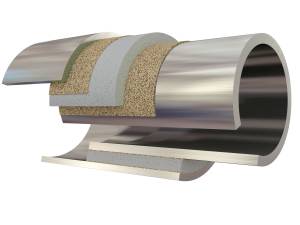
Schematic representation of two tubes connected by hybrid adhesive overlap bonding. (Graphics: Research Center for Steel, Timber and Masonry - KIT Steel and Lightweight Structures)
Technology Market Platform
RESEARCH TO BUSINESS, the technology market platform of KIT, presents another 90 technology offerings at the KIT stand.
KIT in Hall 27, Stand K51 – “Energy”
PHiL: Flexible Test Lab for Future Power Electronics
The energy transition requires the development of new grid structures. The generation of energy from renewable sources and use of this energy in high-consumption applications, such as electromobility, will only be possible with power electronics frequency converters. By the high-precision adjustment of voltages and currents, they supply energy in a safe and tailored manner. For early-stage testing of newly developed frequency converters under real operating conditions, scientists of KIT develop a Power-Hardware-in-the-Loop system (PHiL). As a test environment, it enables reliable simulation of the electrical power grid and all fault cases occurring in it. Continuous improvement of the hardware and software of this test lab allows flexible adaptation and adjustment of all components of the complete system.
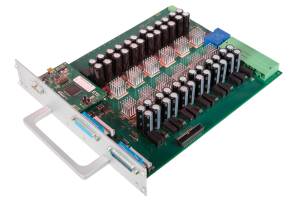
Single-phase voltage source of the modular Power-Hardware-in-the-Loop system (PHiL) for high-performance and highly efficient simulation of the electrical power grid. (Photo: ETI/KIT)
Redox Flow Batteries: Reliable Storage for Renewable Energy
The energy transition needs technical solutions for the decentralized storage of energy from solar and wind power and the compensation of fluctuating production capacities. Apart from the established lithium-ion technology, the redox flow battery offers an innovative solution: It stores electric energy in liquid chemical compounds. The flow battery has a number of advantages that make it particularly suited for medium to large storage projects: Thus, power (kW) and energy (kWh) can be scaled independently of each other. A simple example of an application is the “shifting” of solar energy into the night. Scientists of KIT study options to reduce the costs and make the flow battery technology more reliable. So far, every battery installed had to be adapted manually to a specific application scenario. With the new control system developed by KIT, entire battery clusters can be managed decentrally. Hence, battery modules can be prefabricated and only need to be connected at the installation site.
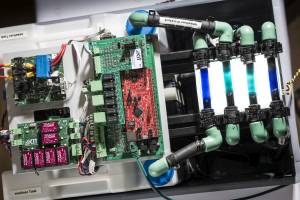
Battery management for decentralized monitoring and control of redox flow batteries enables simple stand-alone operation. (Photo: Markus Breig, KIT)
EDR: Monitoring and Analysis Tool for Electrical Power Grids
As the energy transition progresses, the number of consumers simultaneously power from wind and solar energy on a decentralized level is growing. They replace increasing fractions of production capacity, but hardly serve the grid, as they neither fulfill tasks like voltage stabilization nor provide control energy. In future, smart grids are to fulfill these tasks. Their design and control are based on precise system models and high-resolution measurement data from ongoing grid operation. For this purpose, lectrical engineers of KIT have developed an Electrical Data Recorder (EDR). When installed in the grid near the end consumer or in industrial facilities, the EDR can precisely measure grid voltage and load currents. The EDR, together with data-driven modeling of grid segments and operating resources, will considerably improve the quality of system models and, hence, future control of a smart grid.
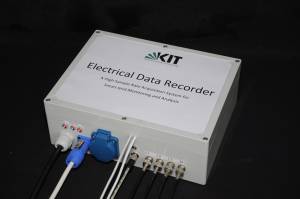
The Electrical Data Recorder supplies high-resolution measurement data from ongoing grid operation – even during voltage losses. (Photo: IAI, KIT)
Startup otego: Microenergy Supply without Battery and Cable
For applications on the Internet of things and in Industry 4.0, thermoelectric generators may offer a good alternative for smallest autonomous consumers: Instead of extracting electric power from battery storage systems or cables, the microgenerators made by KIT’s startup otego GmbH directly produce electric power from surrounding heat sources and, thus, ensure continuous supply. This reduces the maintenance expenditure and the saves resources. Heavy metals, such as tellurium, are not needed at all. Their compact design, the absence of mechanically moving parts, and the use of plastics as base materials make the microgenerators highly robust and reliable. The energy thus supplied can be used to operate a wide variety of sensors, measurement electronics, and wireless systems: From simple products, such as an electronic radiator thermostat, to sensor nodes in larger facilities.
On April 23, 12.30 hrs, Frederick Lessmann, one of the otego founders, will speak about “Industrie 4.0 – Wer wird da eigentlich smart gemacht?” (Industry 4.0 – Who is really getting smart?) at the “Forum Young Tech Enterprises” (hall 17, stand A58).
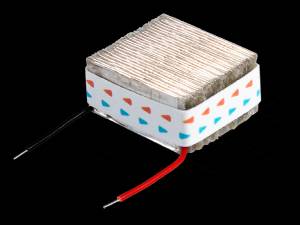
Thermoelectric generator made by otego – not larger than a sugar cube. (Graphics: otego GmbH)
Startup SciMo: Innovative Electric Drive Technologies
The intensive further development of electric drives is crucial to electromobility. While compact and high-performance motors are required, impacts on the environment and manufacturing costs have to be reduced as well. These challenges are addressed by SciMo – Elektrische Hochleistungsantriebe GmbH (SciMo – Electric High-performance Motors), a startup of KIT established in 2017. SciMo has already developed several successful motors that helped KIT’s “Ka-RaceIng” team win the “Formula Student Electric 2016” and were used in the prototype of TU München winning the Hyperloop competition of SpaceX 2017, for instance. The motors main characteristics are their small sizes and high power outputs. The compact design is achieved by an elevatedrotational speed level. By means of a downstream gearbox, the rotational speed of the electric motor can be adapted ideally to various drive scenarios. Innovative cooling methods, such as the indirect groove cooling method optimized by SciMo, allow for very high continuous current densities, which increases the performance of the motors. With these properties, they might also be used as generators in future airborne wind power plants.
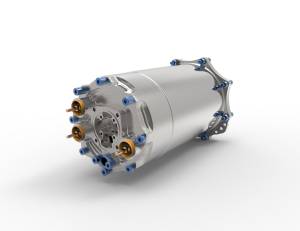
SciMo’s high-revolution synchronous generator with a maximum rotational speed of 30,000 rpm. (Graphcis: SciMo)
Technology Market Platform
RESEARCH TO BUSINESS, the technology market platform of KIT, presents another 30 technology offerings at KIT’s Energy stand. These offerings cover KIT’s innovations which might be translated into marketable products and processes.
ENSURE at Hannover Messe
The ENSURE consortium coordinated by KIT and funded by the Federal Government as one of four Kopernikus projects for the energy transition will also be present at Hannover Messe on Thursday, April 26, 2018. Then, Rik W. De Doncker (RWTH Aachen) will be available to answer questions in the walk-in showroom of the “Integrated Energy Plaza.” In addition, Sascha Altschäffl (TenneT) will speak about ENSURE at the forum “Life needs Power” from 12.30 to 13.00 hrs.
KIT at Other Stands
Joint BIOKON Stand A01, Hall 2: The Body Language of Components
KIT presents innovative methods for lightweight construction and optimization of technical components. These methods have been derived from natural structures, based on Professor Claus Mattheck’s latest book “Pauli Explains the Form in Nature.”
FZI Stand B01, Hall 2: New Robotics Solutions and Networked Driving
The Research Center for Information Technology (FZI) of KIT presents complex robot applications that can be programmed easily and quickly. In addition, the Baden-Württemberg Test Area for Autonomous Driving and a system for manipulated communication between vehicles will be displayed.
VDI Stand C40, Hall 2: Automatic Exposure System
The fully automatic exposure system presented is used to study the impacts of fine dust on health. The system is suited for examining in vitro the effect of fine dust on human lung cells. Aerosols are applied to human lung cells in a reproducible and controllable manner.
Young Tech Enterprises, Stand B74, Hall 17: Startup Teams of KIT Present Themselves
The “Young Tech Enterprises” park gives the dynamic high-tech startup scene a platform to present itself. On all days, startup projects and spinoffs of KIT will introduce themselves: Carol Innovation, µyPrint (Monday, April 23); Knowtion UG, ReTest GmbH (Tuesday, April 24); Heisenberg, Usertimes (Wednesday, April 25); Smartivate, robodev (Thursday, April 26), robodev (Friday, April 27). More information is given at http://www.hannovermesse.de/de/rahmenprogramm/specials/young-tech-enterprises/
The Future of Work – Main Topic of KIT’s Research Magazine and Podcast
Parallel to the start of Hannover Messe, the latest issue of KIT’s research magazine “lookKIT” will be published. It will contain a number of contributions on “Integrated Industry:” From smart factories to digital building management to governance and human resources management in the era of Industry 4.0. Enjoy reading at http://www.sek.kit.edu/english/2142.php.
For the research podcast KIT.audio, author Heiko Bahr met experts of KIT from the areas of computer science, work science, climate research, and technology assessment. In scenarios from industry production to care of the elderly, they point out what future working life may be like and how we are to control the sometimes promising and sometimes threatening development. Listen to our podcast on www.kit.edu/audio
Information on the stands and exhibits of KIT at Hannover Messe 2018 is also given in the digital press kit: www.kit.edu/hannovermesse2018
Being “The University in the Helmholtz Association”, KIT creates and imparts knowledge for the society and the environment. It is the objective to make significant contributions to the global challenges in the fields of energy, mobility, and information. For this, about 10,000 employees cooperate in a broad range of disciplines in natural sciences, engineering sciences, economics, and the humanities and social sciences. KIT prepares its 22,800 students for responsible tasks in society, industry, and science by offering research-based study programs. Innovation efforts at KIT build a bridge between important scientific findings and their application for the benefit of society, economic prosperity, and the preservation of our natural basis of life. KIT is one of the German universities of excellence.

